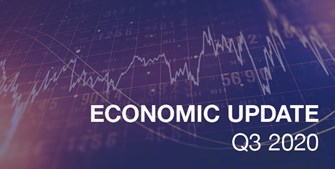The General Picture
The U.S. economy showed resiliency in Q3 of 2020. Pulled up primarily by the government’s pandemic support programs, the consumer and housing sectors propelled the economy back into positive growth territory. While the economy does face momentous headwinds of uncertainty, there is cautious optimism as we head into 2021.
In Q2 of 2020, weighed down by a pandemic, the U.S. economy dropped into recession for the first time in over a decade, posting a 31.4 percent decrease in Gross Domestic Product (GDP). Unemployment rose to 14.7 percent. But Q3 gave us a rebound more robust than predicted. Projections by Fannie Mae show that the GDP could rise by over 30 percent. Unemployment for September improved to 7.9 percent, bolstered by hiring in retail, leisure and hospitality. Consumer spending drove the recovery, soaring by around 40 percent over the quarter. The government’s CARES package boosted the financial security of workers, supported businesses and encouraged forbearance for at-risk borrowers. Pent-up demand, warmer weather and businesses’ ability to adapt to pandemic-restricted consumers buoyed spending. Industrial production, spurred on by manufacturing of durable goods related to consumer buying, also contributed.
While the picture of Q3 affirms the U.S. economy’s resiliency, it is far from where it stood in February. Furthermore, the recovery’s momentum slowed over the course of the quarter, as deferred demand moderated, COVID-19 surfaced in more regions and unemployment support waned.
The Real Estate Sector
The story of the quarter was the startling performance of the residential housing sector. According to the National Association of REALTORS® (NAR), existing home sales surged over 24 percent in July, and in August, reached the highest level since December 2006. In September, Fannie Mae put quarterly growth for Q3 at 35.6 percent for all home sales. Originations are expected to drop slightly quarter over quarter in Q3, mostly due to a reduction in the growth of refinancing, which has led the boom this year. The Mortgage Bankers Association (MBA) projected that purchase originations would increase by about 18 percent.
Spurring this growth are several COVID-19 related factors, including pent-up demand from Q2, a desire for larger and second homes, and CARES support payments. Moreover, low mortgage rates are attracting first-time buyers and record refinances. The 30-year fixed rate in September was down to 2.89 percent compared to 3.72 percent at the beginning of the year. Lenders are in good shape to support strong mortgage originations. All 34 participating banks passed the Federal Reserve’s 2020 stress tests, including the most severe scenario of an extreme recession due to the pandemic.
There were a few moderating forces on the housing market. Data from NAR shows that inventory is tight and while not impacting sales, it is affecting the market. Days on the market dropped from 31 last August to 22 this year and the median existing house price rose 11.4 percent annually in August to $310,600. Fannie Mae forecasts that housing starts for Q3 will not keep pace with demand growth, increasing by 12.3 percent compared to last year. In addition, as reflected in the MBA’s Mortgage Credit Availability Index, mortgage credit tightened over the quarter, hitting its lowest mark since 2014. Uncertainties of the future job market and a reduction in loans to less attractive borrowers contributed to the reduced availability.
This tightening might be in reaction to declining loan performance in Q2. Delinquencies ballooned to 8.2 percent of all loans outstanding, the highest level in nine years, and 8.5 percent of loans were in forbearance. Looking to Q3, Marina Walsh of MBA’s Research and Economics Department noted that “…30-day delinquencies dropped in the second quarter, which is an indication that the flood of new delinquencies may be dissipating.” Moreover, forbearances fell 1.7 percent from June to September as many GSE loans moved into deferral plans, according to MBA’s Weekly Forbearance Surveys.
A Glance Forward
The housing sector predictions for Q4 2020 show a bit of moderation after the explosion of activity in Q3. Home sales and starts will dip slightly in Q4, but still be strong. In September, the MBA projected that 2020 will be the strongest year in originations since 2005. Interest rates and inflation will remain low, while pandemic-related demand for more space persists.
Fannie Mae, the MBA and the Federal Reserve (the Fed) are projecting a restrained expansion in Q4 and a “swoosh” shaped recovery going forward. Fannie Mae expects GDP to grow 6.2 percent in Q4, with only a decline of 2.6 percent for 2020. The MBA projects a Q4 increase of 3.6 percent and agrees with the Fed’s projection of a 3.7 percent decline for 2020. Given smaller GDP growth, unemployment’s improvement will slow, but should easily hit the Fed’s figure of 7.6 percent by year end.
All forecasters mentioned the same influences on the economy. Businesses and people are resilient and adaptable, and consumers will propel the recovery. However, cooler weather and a second wave of the pandemic could dampen activity. The hospitality and retail sectors are expected to continue to struggle, putting a further cap on a faster rebound. Moreover, there is a lot of uncertainty around the election and the lasting impact of altered buying and working habits, as well as the unknown timing of a COVID-19 vaccine. Most importantly, a Congressional extension of paycheck protection and small business support (or lack thereof) should profoundly impact the next two quarters.




